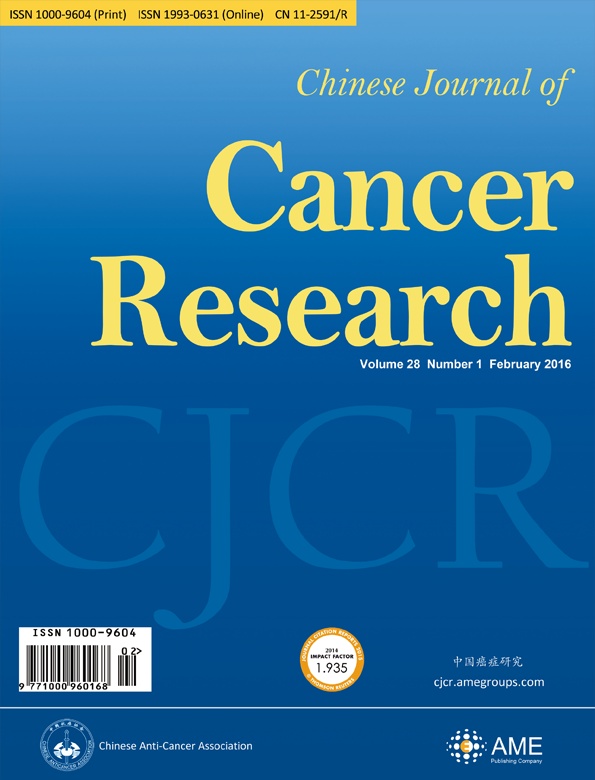CT图像放射组学分析与肿瘤生态系统多样化的耦合:对I - III期结直肠癌总生存率的新见解
IF 7
2区 医学
Q1 ONCOLOGY
引用次数: 1
摘要
目的本研究旨在通过CT图像的放射组学分析与肿瘤生态系统多样性的测量相结合,建立预测I-III期癌症(CRC)患者总生存期(OS)的方法。方法我们回顾性地确定了161名连续接受根治性切除的I-III期CRC患者作为训练队列。共有248名患者被招募作为外部验证队列1进行临时独立验证,103名来自外部研究所的患者被招募为外部验证队列2。利用肿瘤生态系统多样性的测量,提取CT图像特征来描述肿瘤空间异质性,以构建一种标记物,称为EcoRad特征。使用多变量Cox回归来评估EcoRad特征,构建预测模型以证明其对OS预测的传统分期系统的增量价值。结果在训练队列中,EcoRad特征与OS显著相关[风险比(HR)=6.670;95%置信区间(95%CI):3.433−12.956;P<0.001),外部验证队列1(HR=2.866;95%CI:1.646−4.990;P=0.001)和外部验证队列2(HR=3.342;95%CI:12.89−8.663;P=0.002)将EcoRad特征纳入预测模型,与仅纳入肿瘤、淋巴结、,转移(TNM)系统,以及更好的校准、改进的重新分类和优越的临床实用性。结论本研究通过放射组学分析与肿瘤生态系统多样性测量相结合,建立了一种测量CRC空间异质性的方法,并表明该方法可以有效预测OS,可作为I−III期CRC患者风险分层的补充。本文章由计算机程序翻译,如有差异,请以英文原文为准。
Coupling radiomics analysis of CT image with diversification of tumor ecosystem: A new insight to overall survival in stage I−III colorectal cancer
Objective This study aimed to establish a method to predict the overall survival (OS) of patients with stage I−III colorectal cancer (CRC) through coupling radiomics analysis of CT images with the measurement of tumor ecosystem diversification. Methods We retrospectively identified 161 consecutive patients with stage I−III CRC who had underwent radical resection as a training cohort. A total of 248 patients were recruited for temporary independent validation as external validation cohort 1, with 103 patients from an external institute as the external validation cohort 2. CT image features to describe tumor spatial heterogeneity leveraging the measurement of diversification of tumor ecosystem, were extracted to build a marker, termed the EcoRad signature. Multivariate Cox regression was used to assess the EcoRad signature, with a prediction model constructed to demonstrate its incremental value to the traditional staging system for OS prediction. Results The EcoRad signature was significantly associated with OS in the training cohort [hazard ratio (HR)=6.670; 95% confidence interval (95% CI): 3.433−12.956; P<0.001), external validation cohort 1 (HR=2.866; 95% CI: 1.646−4.990; P<0.001) and external validation cohort 2 (HR=3.342; 95% CI: 1.289−8.663; P=0.002). Incorporating the EcoRad signature into the prediction model presented a higher prediction ability (P<0.001) with respect to the C-index (0.813, 95% CI: 0.804−0.822 in the training cohort; 0.758, 95% CI: 0.751−0.765 in the external validation cohort 1; and 0.746, 95% CI: 0.722−0.770 in external validation cohort 2), compared with the reference model that only incorporated tumor, node, metastasis (TNM) system, as well as a better calibration, improved reclassification and superior clinical usefulness. Conclusions This study establishes a method to measure the spatial heterogeneity of CRC through coupling radiomics analysis with measurement of diversification of the tumor ecosystem, and suggests that this approach could effectively predict OS and could be used as a supplement for risk stratification among stage I−III CRC patients.
求助全文
通过发布文献求助,成功后即可免费获取论文全文。
去求助
来源期刊
自引率
9.80%
发文量
1726
审稿时长
4.5 months
期刊介绍:
Chinese Journal of Cancer Research (CJCR; Print ISSN: 1000-9604; Online ISSN:1993-0631) is published by AME Publishing Company in association with Chinese Anti-Cancer Association.It was launched in March 1995 as a quarterly publication and is now published bi-monthly since February 2013.
CJCR is published bi-monthly in English, and is an international journal devoted to the life sciences and medical sciences. It publishes peer-reviewed original articles of basic investigations and clinical observations, reviews and brief communications providing a forum for the recent experimental and clinical advances in cancer research. This journal is indexed in Science Citation Index Expanded (SCIE), PubMed/PubMed Central (PMC), Scopus, SciSearch, Chemistry Abstracts (CA), the Excerpta Medica/EMBASE, Chinainfo, CNKI, CSCI, etc.

 求助内容:
求助内容: 应助结果提醒方式:
应助结果提醒方式:


